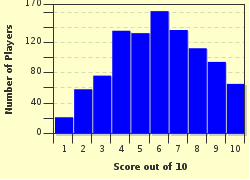Quiz Answer Key and Fun Facts
1. What can children with the rare genetic disease phenylketonuria not eat?
2. Suppose I had a cat that had the genotype bb for its fur color and the phenotype of bb has pink fur. If the cat had the allele B, then it would have purple fur but because it doesn't; it has pink fur. What would the genotype for bb be called?
3. Which of these conditions does NOT cause anemia?
4. What element is present in all proteins, distinguishing them from non-proteins?
5. What is the hormone in plants called which causes them to bend towards the light?
6. What is the scientific term for competition between members of the same species?
7. What happens to someone who has cystic fibrosis?
8. What is a poison that stops the final stage of cellular respiration, the electron transport chain?
9. What is the function of ALL enzymes?
10. What is amensalism?
Source: Author
Alice234
This quiz was reviewed by FunTrivia editor
crisw before going online.
Any errors found in FunTrivia content are routinely corrected through our feedback system.

